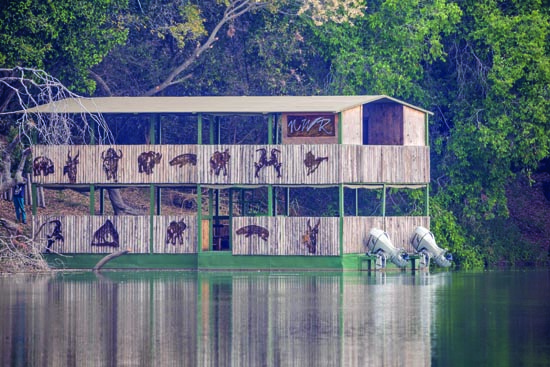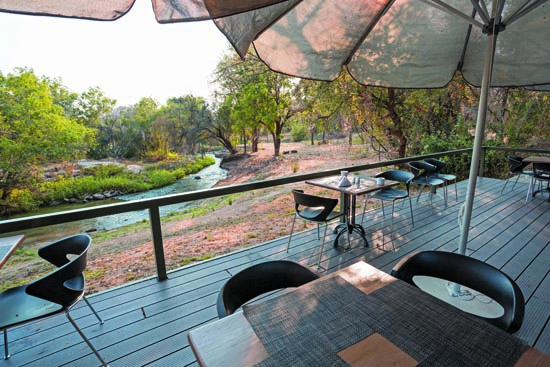Indigenous Plant Products in Namibia
December 8, 2014Namibia’s Bottomless Lakes – Otjikoto & Guinas
December 10, 2014By Annabelle Venter
It’s 26 years since I first visited Popa Falls with my sister. We were young, single, straight from Cape Town and on A Big Adventure. The road between Rundu and Katima Mulilo was gravel and in some places a bit sandy, but we had a ‘have car, will travel’ kind of attitude.
In those days only geologists and farmers had four-wheel drive vehicles, so we made the journey in my sister’s 1975 Ford Escort, packed to the roof with provisions! Our trip coincided with the withdrawal of the South African Defence Force from the Caprivi Strip and it turned into a difficult and treacherous journey while dodging huge army vehicles in heavy clouds of dust as they thundered past in the opposite direction.
We giggled in the gloomy showers (no electricity), made tuna pasta in the communal kitchen, swam in the river, discovered beautiful new colourful birds by torchlight, and checked our beds at night for creepy crawlies, as there was no electricity in the bungalows either. Mice and bats kept us company in the huts, and a female tourist from an adjoining hut asked to sleep in the spare bed in ours because the wildlife in her hut was keeping her awake and terrified! We could hear the hippos honking down in the river and owls screeching through the open mesh walls, holes patched with tissues to keep the mosquitoes out. In the morning a pale, fat snake slithered away while we packed the car.
In the 1980s – the age just before tourism took off – Popa Falls Rest Camp was one of only a handful of tourist accommodation establishments between Rundu and Katima. It seemed to us that only expats and a few tough folk who worked in the area were crazy enough to brave the appalling roads to see these far-flung reaches of the then South West Africa, and we loved the Popa Falls Camp in all its rustic simplicity. Nowadays tar roads slice through the area, and there’s a plethora of places to choose from, with something to suit every pocket and taste. So my husband and I wondered how the new Popa Falls accommodation would fare with the competition. It was with a mixture of anticipation and wistfulness for what might be going forever that we booked two nights at the end of our annual Botswana round trip.
Entering the smart new gates, we’re alert and on the lookout for changes, but initially the camp seems familiar with the old reception house still there, spruced up with a new coat of paint. Then, proceeding down the winding road to reception, the new Popa starts to emerge. Where the old ablution blocks once stood, is now a smart and welcoming reception area. We are welcomed cheerfully by Selma, who directs us to our chalet. Our first impressions are that staff members are happy, and that the buildings blend tastefully into the environment. The soft sound of rushing water is present. The complex has undeniably been designed to maximise its proximity to water.
On the way to our chalet, we drive past the campsites, which seem quite open and hot in the midday sun and, of course, far from the river, situated uphill behind the reception/restaurant complex. Grass is being planted, but there is little shade for most of the sites. Assistant manager Frans Mbambi assures me that trees will be selected and planted there soon.
Arriving at the chalet we slowly walk up the ramp to the deck, not wanting to miss a single feature. A marvellous leafy, cool and peaceful space greets us, the small river mere metres away. Beyond the river lies the island and beyond that, the main channel of the Okavango River, just above the famous falls. There is time to explore later, so we direct our attention to the house. Massive glass doors open the entire room out onto the deck, and pulling back the sheer chocolate-coloured curtain reveals a cool, spacious and sophisticated interior – pure luxury after ten days in our rooftop tent!
We can’t help smiling at this dramatic contrast to those old rustic and windowless bungalows we used to love! We decide we must be getting older and softer, because this is now definitely more appealing! We find no less than four different sitting areas in our chalet, oversized beds, loads of white cotton bedlinen, a kitchenette with fridge and kettle, an air-conditioner, and a lovely spacious bathroom with mirrors to match both our heights. We can even watch giant kingfishers from the shower! Popa Falls has definitely come of age.
We spend the next two days watching the forest dancing before our eyes: giant kingfishers mating in front of our house, a white-browed coucal foraging in the papyrus reeds, a water monitor sliding into the water, and the ever-present choir of birdsong. I think I even saw an otter slip into the water. Eventually we prise ourselves away from our oversized sofa to sample some of the activities now on offer at Popa.
On the first afternoon we decide to take a trip on the river with boatman Claus Kapinga, who hails from the nearby village of Divava. Claus joined Namibia Wildlife Resorts (NWR) in December last year, after working for 25 years at Suclaba (now Divava) Lodge next door. He’s been a boatman for much of that time, so he knows this river like the back of his hand. We’re driven to the launch site – which varies according to the height of the river – by John Lyonga, an old acquaintance who took us on a game drive at Onkoshi last year. John is the first guide to be appointed at Popa Falls. He takes visitors to the Mahango Game Reserve, and also to the Bwabwata National Park across the river. He’s a careful driver and clearly loves his job.
NWR has two flat-bottomed boats, one 10-seater, and one double-decker 30-seater for larger groups. There is a fee per person for a two-hour trip on the river. Drinks are extra and need to be ordered beforehand, although iced water is provided. The river and its banks are full of hippos – three of them bare their teeth aggressively at the boat. Then a malachite kingfisher flits from reed to reed, a white-fronted bee-eater darts in an out of the rushes, and several small crocodiles laze around on the reed-bed. We wave to fishermen who proudly show off their tiger-fish catch. The boat travels as far as Divava village before returning for a sunset view of the falls. A half-hour jaunt just to see the falls can also be booked for those short on time.
The next morning I spend a while with the assistant manager, Frans Mbambi, who also comes from nearby Divava village. He tells me the new Popa Falls Rest Camp was opened in November 2013 and now has 16 two-bedded rooms. Six of these are duets linked by inter-leading doors, making them suitable for accommodating families. These units face the bush and each has an outside private braai amenity. The rest of the chalets face the small river. There are two large communal braai areas for those wanting to self-cater.
Four more luxury chalets facing the main river and the falls (which are more like rapids) have been completed on the island. They are situated on a 3–4-metre-high boardwalk, since hippos graze on the island at night, and will open in November once the furniture arrives. I was interested to see that the old footbridge linking the island to the mainland is still there, and that the new bridge has been constructed right next to it with similar materials as a nod to the old Popa. Frans tells me that a botanist from Rundu will help identify and label the trees on the island, and that a small walking trail is being planned there for daytime use. It’s a magical tangled forest in which I saw several birds I couldn’t identify.
Accommodation at Popa is offered at a bed-and-breakfast rate, while a terrace restaurant overlooking the rapids serves à-la-carte meals. You can watch giant kingfishers and darters fishing while you dine. Occasionally – if there are large groups – a buffet dinner will be served.
Guests can cool off in a small swimming pool next to the Pool Bar. A brisk little walk (past the old campsites) will take you to the Jetty Bar. This is a wooden deck on the white sandy beach, just below the falls. While beautifully situated, it seemed rather unappealing in the midday heat (with no sunshades open and a TV on full blast!).
Activities include the boat trips mentioned above, day-long game drives to both parks, and half-day game drives. A combination game drive and boat trip in the Mahango Game Reserve is being planned, with one of the boats permanently being moored there.
Also on the cards, according to Frans, is catch-and-release fishing in the Mahango Game Reserve. Consent has already been given by the Ministry of Environment and Tourism for this. Surprisingly a spa with a resident beauty therapist is also planned for the future – as if the ambience is not relaxing enough already!
Frans says the former staff members of Popa Falls Rest Camp have been moved temporarily to other NWR resorts for training and to equip them with new hospitality and office skills. The current staff members – who were selected to open the resort – are on contract for a year. After this the intention is to, as far as possible, bring back the old staff members who are local residents.
We concluded our visit by taking a game drive into the Bwabwata National Park with our friend John. We were out for three hours, driving a full 20 km within the reserve, mostly meandering along the floodplain, watching hippos and a variety of birds. We were lucky enough to glimpse a male sable antelope and three elephants coming down to drink as we returned to camp, but were saddened to see how nervous the animals were. Hopefully they will become habituated to the vehicles with time and realise that there is no threat from them. The South African army was based in this park before independence, and current recurring poaching incidents have made the animals understandably skittish.
When all is said and done, our visit to Popa was most enjoyable. We felt that the spirit of the previous camp had been maintained, and left feeling that we would like to return simply to relax and watch the forest!
| An inspiring breakfast tale told by FransAn elderly gentleman arrived at Popa earlier this year on a special quest to find someone from long ago. This gentleman had been a hunter who visited Popa Falls in the 1970s when it was still a hunting camp. One day he saw two young brothers walking along the river’s edge, one of them carrying a water bucket.
Suddenly a crocodile heaved itself out of the water and grabbed the younger brother by the leg. The older one held onto his brother by the arm and tried to beat off the crocodile with the bucket, but to no avail, and the younger boy was dragged into the river. The man had his gun with him, so without hesitation he followed the animal into the water, shot it and retrieved the little boy. Frans tells us that unfortunately they hadn’t been able to find the survivor while the gentleman was visiting. However, the resort manager has since confirmed that he is known to him and still lives in the surroundings. Perhaps these two brave men will still be able to meet up one day after all! |
This article was first published in the Summer 2014/15 issue of Travel News Namibia.






